Women from disaster affected communities provide enormous leadership in times of crisis – they are the first ones on the ground, they often take responsibility for evacuating the injured, the young and the elderly, and safety and security are at the forefront of their agenda. Yet women’s contributions and expertise largely go unnoticed and ignored, much like the unpaid work that women have contributed to families and communities since the beginning of time.
If we are serious about responding to the growing threat of climate change and disasters, then our starting point must be to listen to the voices of those most affected and build upon their existing capability and expertise.
Sabita Rani (pictured above) is an experienced frontline emergency responder and one of those important voices we should be listening to. I first met Sabita in Sendai, Japan in 2015, where world leaders had converged to determine how best to prepare communities everywhere for climate-induced disasters, growing in scale and frequency.
Sabita and I were both members of ActionAid’s delegation, there to advocate for women to be recognised in the global agreements made in Sendai, and for their leadership to be identified as a primary strategy for better supporting communities to prepare for disasters.
Sabita was one of a handful of people at the conference who brought this firsthand experience, and could speak to this issue as powerfully, or knowledgeably. A mother-of-two from a small village in southern Bangladesh, Sabita had personally taken charge, time and time again, to protect her community from the cyclones and floods that were striking more quickly than ever before.
When early warning signals sounded Cyclone Mahasen’s approach in 2013, Sabita and a collective of two dozen women emergency responders were quick to take action.
“We adopted a different approach to men,” Sabita said. “We didn’t want to scare people so we called them and visited them and calmly told them that a cyclone is coming and that they needed to get to safety. We asked them if they needed help to get to the shelter. We asked them if there were pregnant women or elderly people in the house.”
In the hours before Mahasen made landfall, Sabita used her mobile phone to keep in touch with 22 women from neighbouring villages. They led the evacuation effort together.
“The cyclone lasted for 3 hours. Lots of houses were destroyed, trees were uprooted. Many people were badly hurt,” said Sabita. “It was a very difficult environment within which to work. Despite that, we all worked together.”
By the time Cyclone Mahasen had blazed its destructive path through Sabita’s community, the women had led close to 500 villagers to the cyclone shelters that would save their lives.
Sabita’s story is one of many in a movement of women around the globe rising up to ensure their communities are prepared in emergencies. In a growing number of disaster affected communities, women are leading efforts to prepare for emergencies: building bunkers to stockpile food and key documents, drawing up evacuation maps, and running trainings for community members.
When crises strike, women are often the first to sound the alarm – to, like Sabita, lead evacuations, and then manage distributions of food and water, ensuring nobody gets left out.
The work women perform in disasters is nothing short of heroic, but too often these stories go unheard and unrecognised. They were largely unheard by the highest echelons of Sendai representatives and unless we take action together, two years on, they will largely go unheard tomorrow, on World Humanitarian Day.
World Humanitarian Day has long been used to applaud a traditional model of humanitarian response that desperately needs to change: a model where humanitarian heroes are imagined as white men, handing out aid to passive beneficiaries in ‘developing’ countries where black and brown people reside.
The actions of women on the frontlines of disaster – women who respond within their communities- to protect the most vulnerable and provide immediate support – aren’t traditionally commemorated when World Humanitarian Day rolls around each year.
When the bravery and determination of women on the frontlines is brought into sharp focus, when the challenges they’re up against are made clear, it’s difficult to understand why they are so forgotten. Widespread, pre-existing gender inequalities mean that women are disproportionately impacted when disasters and conflict strike. They’re excluded from decision making processes, denied access to resources, and forgotten or sidelined by traditional humanitarian actors.
Despite the system being stacked against them, research has consistently shown that women are the most effective responders to emergencies. When a woman is supported to lead emergency response and recovery processes, she rebuilds more than buildings: she builds her resilience and that of others under her care, enabling communities to recover from shocks and stresses faster, and prepare for disasters before they occur.
On tomorrow’s World Humanitarian Day, ActionAid Australia is hosting a march across the Sydney Harbour Bridge to celebrate women humanitarians like Sabita. The march is an opportunity for Australians to come together to recognise that women like Sabita are the real humanitarian heroes – the heroes a world in crisis so urgently needs.


